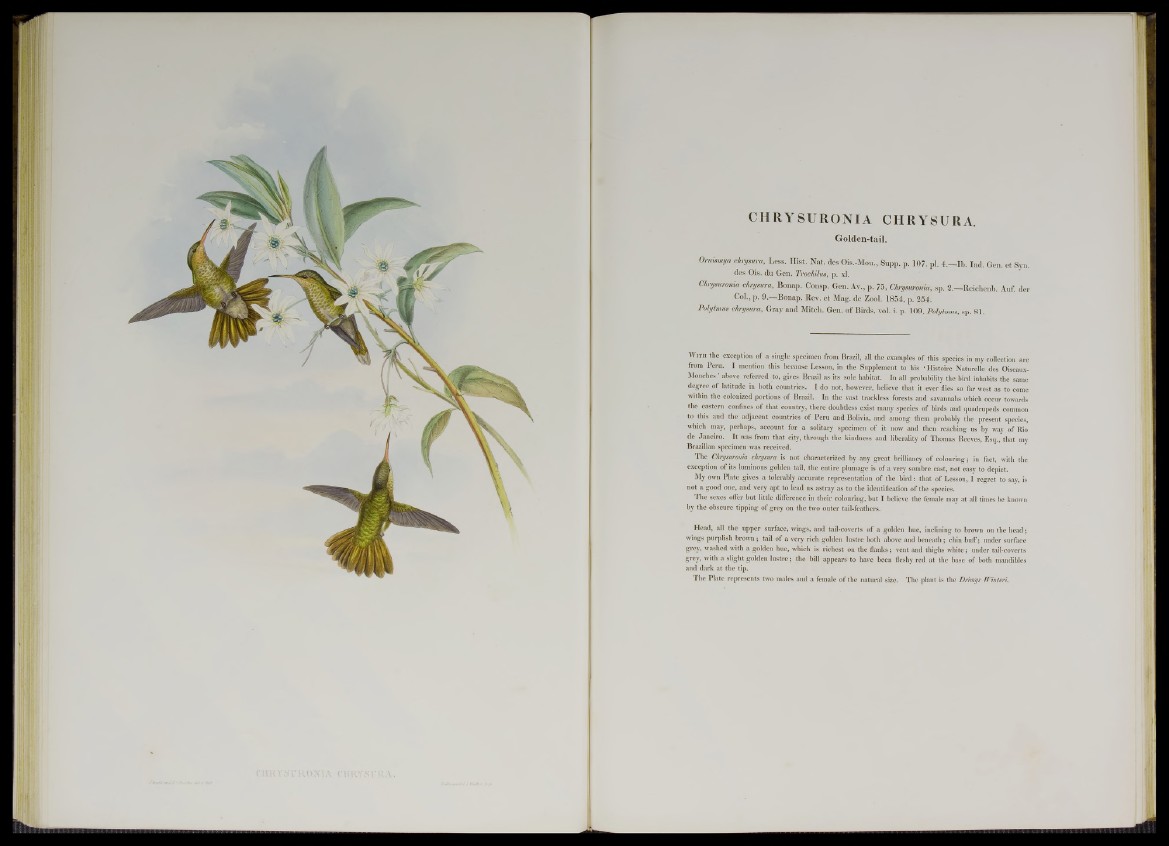
CHRYSURONIA CHRYSURA.
Golden-tail.
Ornismya chrymra, Less. Hist. N at. des Ois.-Mou., Supp. p. 107. pi. 4.— Ib . Ind. Gen. e t Syn.
des Ois. du Gen. Trochilus, p. xl.
Chrymronia chrymra, Bonap. Consp. Gen. At., p. 75, Chrymronia, sp. 2.— Reicbenb. Auf. der
Col., p. 9.—Bonap. Rev. e t Mag. de Zool. 1854, p. 254.
Polytmm chrymra, Gray and Mitch. Gen. o f Birds, vol. i. p. 109, Polytmm, sp. 81.
W ith the exception of a single specimen from Brazil, all the examples of this species in my collection are
from Peru. I mention this because Lesson, in the Supplement to his ‘ Histoire Naturelle des Oiseaux-
Mouches' above referred to, gives Brazil as its sole habitat. In all probability the bird inhabits the same
degree of latitude in both countries. I do not, however, believe that it ever flies so far west as to come
within the colonized portions of Brazil. In the vast trackless forests and savannahs which occur towards
the eastern confines of that country, there doubtless exist many species of birds and quadrupeds common
to this and the adjacent conntries of Peru and Bolivia, and among them probably the present species,
which may, perhaps, account for a solitary specimen of it now and then reaching us by way of Rio
de Janeiro. It was from that city, through the kindness and liberality of Thomas Reeves, Esq., that my
Brazilian specimen was received.
The Chrysuronia chrysura is not characterized by any great brilliancy of colouring; in fact, with the
exception of its luminous golden tail, the entire plumage is of a very sombre cast, not easy to depict.
My own Plate gives a tolerably accurate representation of the bird: that of Lesson, I regret to say, is
not a good one, and very apt to lead us astray as to the identification of the species.
The sexes offer but little difference in their colouring, but I believe the female may at all times be known
by the obscure tipping of grey on the two outer tail-feathers.
Head, all the upper surface, wings, and tail-coverts of a golden hue, inclining to brown on the head;
wings purplish brown; tail of a very rich golden lustre both above and beneath; chin buff; under surface
grey, washed with a golden hue, which is richest on the flanks; vent and thighs white; under tail-coverts
grey, with a slight golden lustre; the bill appears to have been fleshy red at the base of both mandibles
and dark at the tip.
The Plate represents two males and a female of the natural size. The plant is the Drimys Winteri.